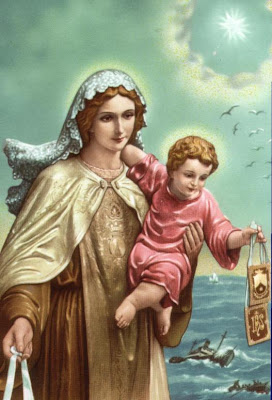 Everybody needs a Jewish grandmother. There is no need too small or insignificant for St. Anne to concern herself with; she is at home among the pots and pans, in the garden, the grocery store, and especially in the labor and delivery room. I can even see her standing in the living room in the middle of a family fight, trying to intervene. She is powerful with God. Her shrine in Quebec is among the most beautiful in the world. From Abbot Gueranger:
Everybody needs a Jewish grandmother. There is no need too small or insignificant for St. Anne to concern herself with; she is at home among the pots and pans, in the garden, the grocery store, and especially in the labor and delivery room. I can even see her standing in the living room in the middle of a family fight, trying to intervene. She is powerful with God. Her shrine in Quebec is among the most beautiful in the world. From Abbot Gueranger:What human lips, unless touched like the prophet’s with a burning coal, could tell the admiring wonder of the Angelic Powers, when the Blessed Trinity, passing from the burning Seraphim to the lowest of the nine choirs, bade them turn their fiery glances and contemplate the flower of sanctity blossoming in the bosom of Anne? The Psalmist had said of the glorious City whose foundations were now hidden in her that was once barren: The foundations thereof are in the holy mountains; and the heavenly hierarchies crowning the slopes of the eternal hills, beheld in her heights to them unknown and unattainable, summits approaching so near to God, that he was even then preparing his throne in her. Like Moses at the sight of the burning bush on Horeb, they were seized with a holy awe on recognizing the mountain of God in the midst of the desert of this world; and they understood that the affliction of Israel was soon to cease. Although shrouded by the cloud, Mary was already that blessed mountain whose base, i.e., the starting point of her graces, was set far above the summits where the highest created sanctities are perfected in glory and love.
How justly is the mother named Anne, which signifies grace, she in whom for nine months were centered the complacencies of the Most High, the ecstasy of the Angelic Spirits and the hope of all flesh! No doubt it was Mary, the daughter, and not the mother, whose sweetness so powerfully attracted the heavens to our lowly earth. But the perfume first scents the vessel which contains it, and even after it is removed, leaves it impregnated with its fragrance. Moreover, it is customary to prepare the vase itself with the greatest care; it must be all the purer, made of more precious material, and more richly adorned, according as the essence to be placed in it is rarer and more exquisite. Thus Magdalene enclosed her precious spikenard in alabaster. The Holy Spirit, the preparer of heavenly perfumes, would not be less careful than men. Now the task of blessed Anne was not limited, like that of a material vase, to passively containing the treasure of the world. She furnished the body of her who was to give flesh to the Son of God; she nourished her with milk; she gave to her, who was inundated with floods of divine light, the first practical notions of life. In the education of her illustrious daughter, Anne played the part of a true mother: not only did she guide Mary’s first steps, but she cooperated with the Holy Ghost in the education of her soul, and the preparation for her incomparable destiny; until, when the work had reached the highest development to which she could bring it, she, without a moment’s hesitation or a thought of self, offered her tenderly loved child to him from whom she had received her. (Read more.)
St. Anne, Beauty of Judea, Mother of the Virgin, pray for us!
(Artwork by Leonardo da Vinci)













_F0173k.jpg)























